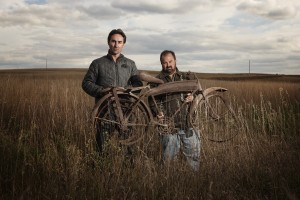During the past few weeks, after reading about them in the press and being urged by friends, I finally got around to watching American Pickers and Pawn Stars, a pair of History documentary reality TV series based around the business of buying and selling antiques and collectibles. Both shows are part of a virtual explosion of reality series airing new episodes this summer. Predictably, though, much of this programming is designed to replicate successful themes and formats. For instance, American Pickers and Pawn Stars combine the BBC’s and PBS’s long-running Antiques Roadshow collectibles appraisal format with the spectacle, humor, and adventurous spirit of the many extreme and/or bizarre jobs reality series, ranging from Deadliest Catch and Ice Road Truckers to American Choppers and Miami Ink/LA Ink. (Other recent collecting-themed reality series like A&E’s Hoarders focus on compulsive behavior, and thus more closely resemble the various human freak show-style reality shows.)
Pawn Stars was the first of this pair to reach the air, debuting back in July 2009. Already in its third season, the series centers around the Gold & Silver Pawn Shop in Las Vegas, owned and operated by three generations of the Harrison family. The setup is simple: customers bring in items to sell or pawn, the staff appraises them and/or calls in an expert to do so, and then they haggle over the price. The emphasis is on unique artifacts – vintage toys, weapons, Word War II memorabilia, rare coins, et al (as opposed to more commonly pawned items like jewelry or electronics) – and during the appraisal process some historical knowledge is always revealed. Americans Pickers, which only premiered in January but is already in its second season, follows a similar format, except rather than have the customers come to them, the show’s protagonists, Iowans Mike Wolfe and Frank Fritz (pictured above), go to the customers. Travelling the country, the Pickers – named that because, unlike an antique dealer in a shop, they scrounge through junk heaps and people’s homes to “pick” out rare items that they then resell to dealers or collectors – spend most of their time on back roads and farms. Indeed, both shows seem very calculated in their attempts to cultivate blue-collar appeal: they’re set in middle America; the Pawn Stars and Pickers mainly purchase everyday and pop culture type objects; and the guys even look like average Joes (they all ride motorcycles, to boot).
The two shows have been ratings successes. When it debuted in January, American Pickers had the most-watched History series premiere since Ice Road Truckers in 2007. Back in June, the Monday night block of Pawn Stars and Pickers attracted the History network’s largest audience ever. But the shows haven’t been without controversy either, especially Pickers. Just do a little Googling and you’ll quickly find viewers reviling Mike and Frank for taking advantage of the elderly and others who have saved these collectibles for a lifetime but have little to no idea about their monetary value. Those within the antiques community, including none other than John Fiske, have also taken issue with the duo’s ethics and their role in buttressing the public perception of antique dealers as rogues and thieves. (Pawn Stars seems to escape these criticisms because the owners are always the ones bringing the objects to the Gold & Silver Pawn Shop looking for a payday.)
While those are intriguing points to consider, I find it particularly interesting that these shows about antiques and collectibles are emerging and prospering during a period of economic recession. The value of the objects featured in the shows frequently run into the thousands and even tens-of-thousands of dollars, and it seems hard to believe that there are many people out there actively buying up such high-priced collectibles right now. Indeed, the Pawn Stars and the Pickers are middle men in all of this; the collectors who purchase this stuff from the pawn shop and the Antiques Archaeology store are never seen, even though we are assured that they are out there. Nevertheless, I believe the audience interest in these shows is driven less by a desire to be a collector and buy these collectibles than it is to sell them. At a time when so many Americans are losing money and cutting back, it is reassuring to see that our junk really might be gold.
Indeed, the type of collectibles featured in these shows does not resemble what most people think of when they think of antiques. That is, these are not Tiffany lamps, Fabergé eggs, or Chippendale furniture, but rather motorcycles, toys and games, folk art, tools, advertising signs, and other industrial and mass-produced goods primarily from the recent past. In other words, these are the type of things that most average Americans or their families either own, at some point owned, or very well could own and not even know it (who knows what grandma has stashed away in the attic?!). Shows like Pawn Stars and Pickers give us hope that all the stuff we’ve been collecting and saving might actually have more than sentimental value, and might help get us through these tough times. I doubt I’m the only one who has dug through the basement late on a Monday night, thinking, “Hey, I have one of those!”


















